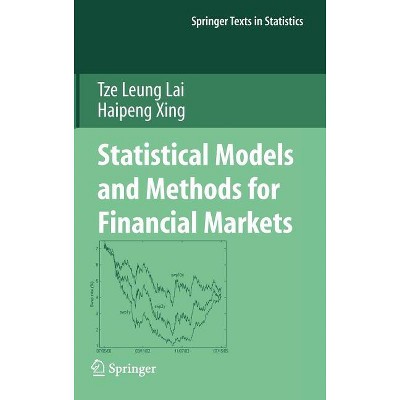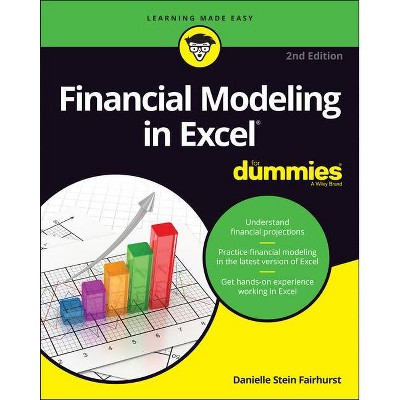Sponsored

New Methods in Financial Modeling - by Hugh Neuburger & Houston Stokes (Hardcover)
In Stock
Sponsored
About this item
Highlights
- The authors present a number of financial market studies that have as their general theme, the econometric testing of the underlying econometric assumptions of a number of financial models.
- About the Author: HOUSTON H. STOKES is Professor of Economics at the University of Illinois at Chicago.
- 168 Pages
- Business + Money Management, Economics
Description
About the Book
The authors present a number of financial market studies that have as their general theme, the econometric testing of the underlying econometric assumptions of a number of financial models. More than 30 years of financial market research has convinced the authors that not enough attention has been paid to whether the estimated model is appropriate or, most importantly, whether the estimation technique is suitable for the problem under study. For many years linear models have been assumed with little or no testing of alternative specification. The result has been models that force linearity assumptions on what clearly are nonlinear processes. Another major assumption of much financial research constrains the coefficients to be stable over time. This critical assumption has been attacked by Lucas (1976) on the grounds that when economic policy changes, the coefficients of macroeconomics models change. If this occurs, any policy forecasts of these models will be flawed. In financial modeling, omitted (possibly non-quantifiable) variables will bias coefficients. While it may be possible to model some financial variables for extended periods, in other periods the underlying models may either exhibit nonlinearity or show changes in linear models. The authors research indicates that tests for changes in linear models, such as recursive residual analysis, or tests for episodic nonlinearity can be used to signal changes in the underlying structure of the market.
The book begins with a brief review of basic linear time series techniques that include autoregressive integrated moving average models (ARIMA), vector autoregressive models (VAR), and models form the ARCH/GARCH class. While the ARIMA and VAR approach models the first moment of a series, models of the ARCH/GARCH class model both the first moment and second moment which is interpreted as conditional or explained volatility of a series. Recent work on nonlinearity detection has questioned the appropriateness of these essentially linear approaches. A number of such tests are shown and applied for the complete series and a subsets of the series. A major finding is that the structure of the series may change over time. Within the time frame of a study, there may be periods of episodic nonlinearity, episodic ARCH and episodic nonstationarity. Measures are developed to measure and relate these events both geographically and with mathematical models. This book will be of interest to applied finance researchers and to market participants.
Book Synopsis
The authors present a number of financial market studies that have as their general theme, the econometric testing of the underlying econometric assumptions of a number of financial models. More than 30 years of financial market research has convinced the authors that not enough attention has been paid to whether the estimated model is appropriate or, most importantly, whether the estimation technique is suitable for the problem under study. For many years linear models have been assumed with little or no testing of alternative specification. The result has been models that force linearity assumptions on what clearly are nonlinear processes. Another major assumption of much financial research constrains the coefficients to be stable over time. This critical assumption has been attacked by Lucas (1976) on the grounds that when economic policy changes, the coefficients of macroeconomics models change. If this occurs, any policy forecasts of these models will be flawed. In financial modeling, omitted (possibly non-quantifiable) variables will bias coefficients. While it may be possible to model some financial variables for extended periods, in other periods the underlying models may either exhibit nonlinearity or show changes in linear models. The authors research indicates that tests for changes in linear models, such as recursive residual analysis, or tests for episodic nonlinearity can be used to signal changes in the underlying structure of the market.
The book begins with a brief review of basic linear time series techniques that include autoregressive integrated moving average models (ARIMA), vector autoregressive models (VAR), and models form the ARCH/GARCH class. While the ARIMA and VAR approach models the first moment of a series, models of the ARCH/GARCH class model both the first moment and second moment which is interpreted as conditional or explained volatility of a series. Recent work on nonlinearity detection has questioned the appropriateness of these essentially linear approaches. A number of such tests are shown and applied for the complete series and a subsets of the series. A major finding is that the structure of the series may change over time. Within the time frame of a study, there may be periods of episodic nonlinearity, episodic ARCH and episodic nonstationarity. Measures are developed to measure and relate these events both geographically and with mathematical models. This book will be of interest to applied finance researchers and to market participants.About the Author
HOUSTON H. STOKES is Professor of Economics at the University of Illinois at Chicago. The author of more than 75 articles and four books, he has consulted widely in finance, health economics, and energy economics. His main research in recent years involves the development and application of diagnostic procedures for the specification of econometric models, which is the topic of his 1991 Quorum book, Specifying and Testing Econometric Models (Second Edition, 1997).
HUGH M. NEUBURGER is Senior Vice President and Director of Growth Equities at DLJ Investment Management Corp., Donaldson, Lufkin & Jenrette, New York. He has taught at the Columbia University Graduate School of Business, and has published more than 20 articles. He was also Managing Director and Cofounder of Matrix Capital Management and a Director in the Pension Asset Management Group of the Prudential Insurance Company.










